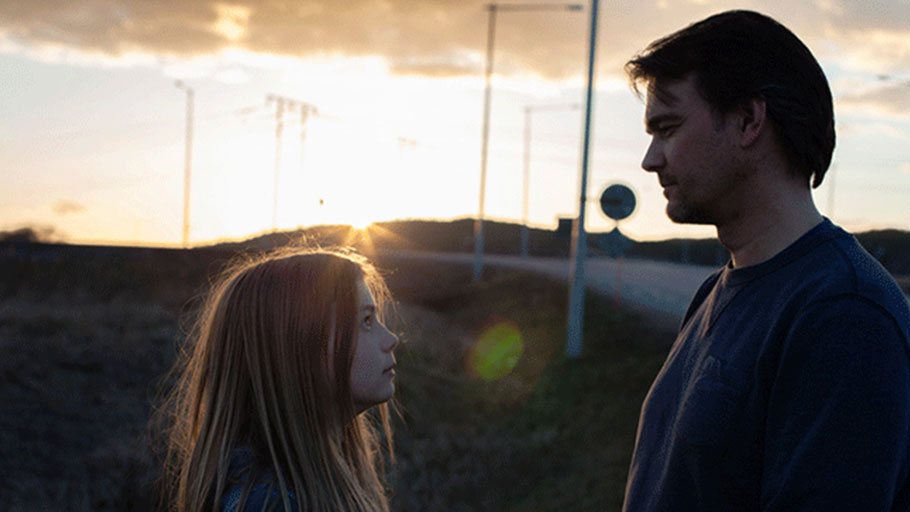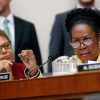“There can be no end to white supremacy until white folks renounce its spoils and privileges.” Photo by Johner Images, Getty Images.
What it looks like to pay for the unearned advantages my whiteness has afforded me.
By Chris Moore-Backman, Yes Magazine —
I had a fascinating breakfast conversation with my 11-year-old daughter a few days back. The night before I had a fitful dream—one that was short on plot and imagery, but chock-full of emotion. In this case, the feeling was of a deep, immovable sorrow. When I awoke, it didn’t take long to recognize that the article I’d been working on—this article—was definitely working on me, too.
During breakfast I knew my daughter could tell I wasn’t on solid ground. She’s a sensitive soul, and I figured I should go ahead and tell her what was going on. “I’m struggling with my article, Isa,” I told her. She already knew that I was working on a piece about reparations. The word was new to her, though the concept was second-nature. She took a bite of her apple as I continued: “What do you do when there’s more damage than you could ever hope to repair?” Still chewing, Isa gently prodded me with her eyes, not quite understanding what I was getting at. “Like with what white people have done—and continue to do—to Black people and to Native Americans,” I said. “All the violence and theft. All the broken promises. What do you do when there’s so much more than you could possibly repair?”
Isa finished her bite, then spoke without hesitation: “You should repair as much as you can,” she said. “And then you should teach young people about what happened, so it doesn’t happen again.” Guileless, she took another bite from her apple. It gave her time to find the rest of her answer: “And you need to say sorry.”
The end of an age, the advent of a movement of movements
The most hopeful interpretation I’ve heard of the still-surreal outcome of November’s presidential election is that Donald Trump’s ascendancy does not mark the beginning of a new era so much as the end of an age. While the new president and his supporters champion their Reaganesque revival, some intuit this shocking swing of the pendulum as the official beginning of the end for the reign of capitalism, patriarchy, and white supremacy.
It’s a gargantuan claim, to say the least. And, in view of our current circumstances as a civilization, we’d better hope it’s on the mark.
The intensification of social crises around the world and the threat of all-out ecological collapse have made clear that the time for global action has more than arrived. But our current multifaceted emergency also signals that the scale and character of the action now needed to point to the rising up of more than a movement. A growing number of changemakers have begun pointing to the emergence of a massive movement of movements as our greatest hope. In her essay “Let Them Drown: The Violence of Othering in a Warming World,” Naomi Klein describes the indivisibility of capital-driven violence against the Earth and systemically racist violence against people of color. In the end she reaches the conclusion that “the most pressing task” must be that of “strengthening the threads tying together our various issues and movements.” This, she argues, is “the only way to build a counterpower sufficiently robust to win against the forces protecting the highly profitable but increasingly untenable status quo.”
We’re in a bona fide all-hands-on-deck situation here. To rally the strength and vision our historical moment requires, our many and varied social and ecological movements are being called beyond mere collaboration and intersectionality. We’re being called to a level of coherence and unity unlike anything we’ve ever experienced.
And this is where it gets really tricky and plenty overwhelming. As a white person who has moved in a variety of multiracial movement spaces, I have a sense of what the above assignment actually entails. I’ve come to know something of the vast distance between collaboration and true coherence. It’s more or less equal, I’ve found, to the distance we whites tend to fall short of genuinely meriting the trust of our sisters and brothers of color.
And let’s be clear: In the context of our nation’s tortured racial history and present, when it comes to the work of establishing such trust, the lion’s share of responsibility falls to us.
Preaching to the choir
The purpose of this article is not to persuade readers still on the fence about the moral and practical necessity of reparations in the United States. For that reason, I’m not dwelling here on the egregious disparities of wealth, income, employment, education, health care, and criminal justice that so define the racial landscape of this country, and which can be easily traced to white supremacist crimes against humanity perpetrated here, such as slavery and genocide, and to the contemporary racist systems and structures that are the living legacy of those crimes. Neither am I connecting the white privilege dots for folks whose knee-jerk response to the mention of reparations is, in one form or another: “But that was so long ago,” or, “My family never owned slaves or stole land from anybody.”
Plenty of articles have covered all of the above extensively. My purpose here is different. I’m addressing white folks already in the choir to make the case that at the cusp of the convergence of a great movement of movements, the widespread, systematic enactment of reparations for the victims of white supremacy in the U.S. should be at the top of our social change priority list.
I say this cognizant of the fact that those of us who identify as white, or who are identified as white in our society, represent a huge and unwieldy spectrum. The spoils of slavery, genocide, and continuing systemic racism are distributed among us in a most unequal fashion. The call for reparations doesn’t frame white America as a monolith. Rather, it challenges each of us to take responsibility for our part and to repair what we can and should.
Systemic reparations move us forward, but only so far
Recent reparations developments bear both hope and warning. In Chicago, the ordinance for victims of police torture represents a crucial advance. Daniel Hunter, an organizer and activist trainer with Training for Change, applauds the achievement.
“What I love about the Chicago reparations is that they model that a systemic problem has to be solved with systemic answers,” he says. “Reparations can’t merely be an exchange of capital. It needs to require that systems themselves change and become better.” Torture victims and community organizers in Chicago have concretized what many have assumed would never get out of the realm of fantasy. Their success makes the call for more sweeping forms of reparations seem far less ethereal.
Meanwhile, just days prior to the inauguration of our nation’s 45th president, resilient, if battle-weary, Congressman John Conyers reintroduced congressional bill HR40, the Commission to Study and Develop Reparation Proposals for African-Americans Act. The bill was originally introduced in 1989, and Conyers has reintroduced it each and every congressional term since, and he vows to do so until it passes. Although the bill’s chance of passing in our current political climate is as slim as ever, racial justice advocates take heart that such national legislation stands ready for the day the tide turns.
While the Chicago ordinance represents a crucial stride for justice, and HR40 promises even more sweeping justice, it’s important to acknowledge their serious limitations. Neither adequately and directly addresses the core dilemma facing us in relation to white supremacy, which is, after all, the fundamental cause of the need for reparations. Neither Chicago’s reparations nor HR40 asks, encourages, or challenges everyday white folks—including everyday progressive and radical white folks—to renounce their routine enjoyment of the fruits of white supremacy.
Hunter’s point is crucial: Systemic injustice requires a systemic response. But a critical part of that systemic response must speak to the moral responsibility of regular white folks and challenge us into new ways of thinking and behaving.
Why? Because there can be no end to white supremacy until white folks renounce its spoils and privileges. The core dilemma for those of us who are white is that we don’t get to bring white supremacy with us to the other side of the transition to a white supremacy-free society. As Michelle Alexander puts it: “Nothing short of a radical shift in public consciousness holds any hope for us to end, once and for all, our nation’s history and habit of creating caste-like systems in America.” We’re in need of a comprehensive reparations approach that reflects and nurtures this radical shift, an approach that’s powerful enough to catalyze what Ta-Nehisi Coates calls “a national reckoning.” For white folks, this means that reparations need to be nothing less than jarring. If we’re not feeling seriously disoriented, the needed shift probably isn’t happening.
Reparations at the grassroots
A radically hopeful beginning would be for those of us who are white and who are already awake to the moral rightness and necessity of reparations to set aside enough time for some brutally honest personal inquiry: What might it look like for me to offer reparations right now, in direct proportion to the unearned advantages (including, for those of us who have it, surplus wealth) that my whiteness has afforded me?
The fact is we need not wait for a governmental decree or the findings of an official commission to make a start, and we need not limit ourselves to a definition of reparations as programmatic forms of financial compensation. Some inspiring and instructive experiments are underway right now.
Near La Plata, Missouri, core members of the Possibility Alliance, a land-based intentional community and hub for nonviolence education and organizing, have reached out to local indigenous people and to an indigenous historian to learn the history of the land on which they live. “In the early years of my environmentalism, there was this idea of, ‘Oh, we’ll just live simply and practice nonviolence, and everything will be good,’” says Ethan Hughes, co-founder of the project. “But we’ve realized that if we don’t take acts, however imperfect, to try to heal these relationships, all the other work will be for naught.”
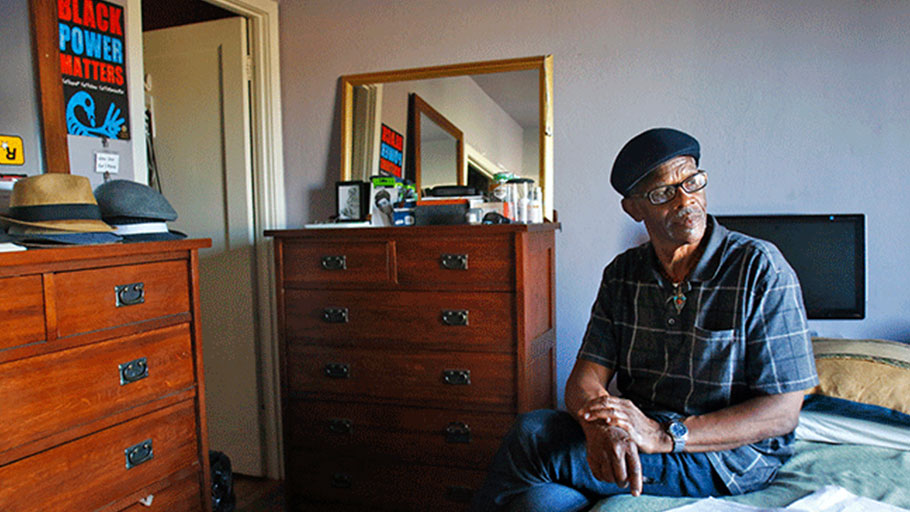
Watani Stiner sits in his room at the restorative justice-centered house Sister Water, at Canticle Farm in the Fruitvale District in Oakland, Calif. Stiner, a former member of the Black nationalist group US, was sentenced to life in prison following the 1969 shootout at UCLA, in which two members of the Black Panther Party were shot and killed as activist groups called for the founding of a Black studies program at the university. Now, after being released, Stiner leads monthly speaking engagements at high schools, colleges, and organizations centered on criminal justice. Living at Sister Water, he says, has helped him discover his passion for speaking and makes his “journey worthwhile.” — Photo by Veronica Weber.
As the Possibility Alliance plans to scale down and relocate, they are looking to return some or all of 110 acres to local indigenous groups. In addition, with their sights now set on Belfast, Maine, the community has reached out to members of the Wabanaki Nation there to seek its blessing for the project’s relocation to the tribe’s historic land and to ask how to be of service. “Whether it’s in relation to the African American history of kidnapping, slavery, and genocide, or the Native American history of kidnapping, stolen land, and genocide, if we don’t try to heal these relationships, there can never be a healed humanity and Earth,” Hughes says.
In the Fruitvale District of Oakland, California, the urban intentional community Canticle Farm is experimenting with another approach to reparations. Anne Symens-Bucher, a founding member of the small-scale farm, recently turned to the project’s extended network of white supporters to raise funds to purchase a home on an adjacent lot. Upon completing some needed renovations on the newly acquired home, Canticle Farm opened its doors to men of color who had been paroled from life sentences. The vision and restorative justice-based program of the home is now steered by its residents, in partnership with the rest of the Canticle Farm community.
Symens-Bucher explains that the prisoner re-entry house represents a small initial response to the grave, race-based injustices and disparities that characterize our society and are starkly epitomized by our criminal justice system. “The Preamble to the United States Constitution begins with the words, ‘We the People,’” she says. “There’s a silver lining to the fact that there has yet to be official reparations to people of color for the generations of genocide inflicted by this nation. It puts the responsibility back on our shoulders.”
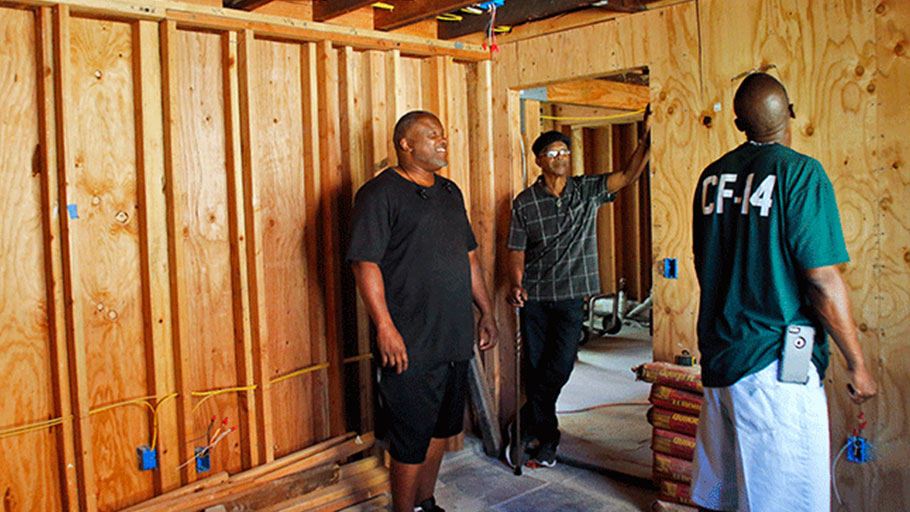
From left, Troy Williams, Watani Stiner, and Salin Johnson take a look around at their former garage, which is currently being converted to a downstairs unit with additional bedroom and office space to accommodate future residents of Sister Water. — Photo by Veronica Weber
Also in the Bay Area, the local and all-volunteer chapter of Showing Up for Racial Justice, a national network of groups and individuals organizing white people for racial justice, has placed reparations at the center of its work. Therefore, fundraising is a core function of its operations.
“For us, fundraising is first and foremost an opportunity for political education,” says Elliot Karl, co-chair of Bay Area SURJ’s fundraising committee. “Our task is to help white folks situate themselves in our nation’s history of racial injustice and inequity, to see their access to wealth and resources as resulting from that context, and to begin understanding reparations as an integral part of how they can participate in the movement.”
Bay Area SURJ has pledged that their entire annual programming budget will be matched dollar for dollar in unconditional donations to the people of color-led organizations with which they collaborate. That budget foots the bill for their political education and outreach programs, direct action training and mobilization, and more.
Over the past year, the group has surpassed their fundraising goal. The program expenses since July 2016 were just over $30,000, while funds raised for partner organizations totaled more than $110,000. Nevertheless, Karl is slow to tout the accomplishment. Nor does he cite his group’s reparations efforts as a case of special initiative on the part of white people. “We’re responding to a longstanding call from communities of color,” he says. “As far as we’re concerned, this is a moral obligation.”
Affirming and answering the demand
The demand for reparations is indeed a longstanding call. When asked about it, Dorsey Nunn, executive director of Legal Services for Prisoners with Children and co-founder of All of Us or None, doesn’t mince his words: “Hell, Black folks have been working this thing since 40 acres and a mule!”
Of late, thought-leaders Ta-Nehisi Coates and Michael Eric Dyson are among the most notable reparations advocates, while the collective platform of the Movement for Black Lives heralds its own powerful and systematic set of reparations demands.
As self-evident as it may seem, it’s critical to acknowledge that such demands for reparations are raised—almost without exception—by people of color. The absence of white voices echoing this demand, and the absence of white action answering it, epitomize the grip of our supremacy. It’s past time that we who have received undue benefit from our ancestors’ wrongdoings, and who continue to receive undue benefit from our nation’s systemic racism, humbly and unequivocally affirm and answer the demand.
My daughter Isa’s response to me a few mornings back gives us a concise and powerful lead to how we might do so:
“Repair as much as you can.”
Nunn encourages white folks to connect with, and channel their resources toward, the groups working to advance the comprehensive reparations demands put forth in the Movement for Black Lives platform. Whether it’s free and full access to education, a guaranteed minimum livable income, or the ensuring of access to and control of food sources, housing, and land for all Black people in the U.S., the reparations plank of this historic platform offers a wide variety of entry points for white folks looking to offer support.
Christine Nobiss, Plains Cree-Salteaux of the George Gordon First Nation in Saskatchewan and founder and chair of Indigenous Iowa, encourages whites to begin by learning whose land they live on. From there, she advises humbly reaching out to the indigenous people of that land, in order to recognize them and to offer to be of service. She also encourages support for new indigenous-led movement-building camps that are being established around the country, such as Little Creek Camp in Iowa, where she resides. “Social and environmental justice are inextricably linked,” she says. “These camps really get that, which is part of the reason they’re so important.”
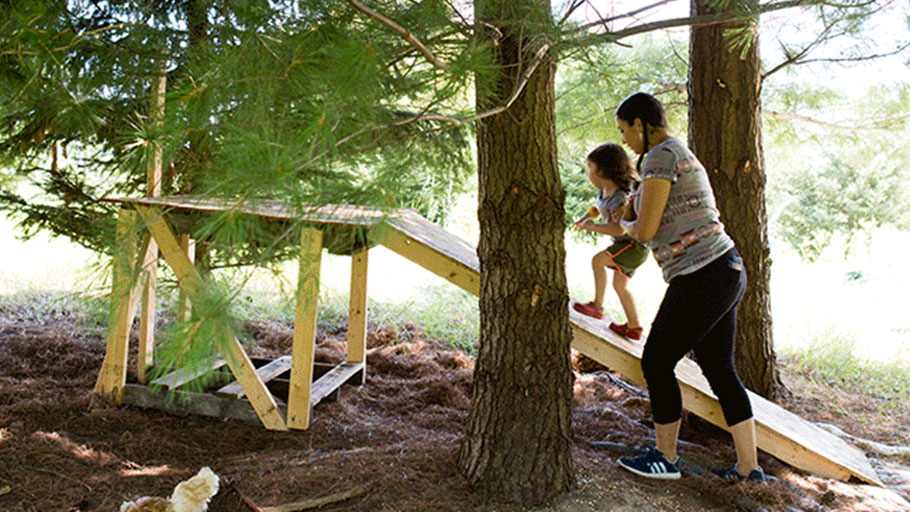
Christine Nobiss, Plains Cree-Salteaux of the George Gordon First Nation in Saskatchewan and founder and chair of Indigenous Iowa, lives with her family on land lent to them by a local property owner to continue the social justice work they found at Standing Rock. — Photo by Jen Madigan.
Nobiss insists that reparations must be multifaceted and believes that direct action can be one of its most powerful expressions. “It’s all about intention,” she says. “We saw reparations on the front lines at Standing Rock, when white people—who had come to realize how much violence and abuse people of color are facing—put their bodies in front of indigenous people to protect them. I can’t think of a more intrinsic example of reparations than of putting your own life on the line.”
“Teach young people about what happened, so it doesn’t happen again.”
The second dimension of Isa’s action plan also steers us to the reparations demands of the Movement for Black Lives platform, one of which is a thorough revamping of school curricula to ensure that African and African American-centered history, struggles, and accomplishments are respectfully and adequately taught. The bottom line being that treating such content as an add-on, if that, to white-centric curricula is a grievous example of white supremacy that needs to go. What’s needed instead is holistic, truth-telling curricula that presents Black subject content “as part of an ongoing narrative of oppression and resilience, not as historical artifacts.” Clearly the same holds true for Native American content, and that of the other groups that have been victims of white supremacy in the U.S.
Another layer of this educational revamp should encourage young people to focus on the experience of the oppressor class as well. White anti-racism author and educator Tim Wise astutely observes the deeply damaging ways that white supremacy “doubles back” on whites themselves, and that this needs to be addressed if we’re going to move in the direction of authentic healing. “One of the things white supremacy required of white people was the death of empathy,” Wise says. “Only by causing us to numb ourselves to the pain of others could otherwise decent people (which most white folks are) collaborate with such a monstrous system.” If we’re going to “teach young people about what happened,” this part must be included.
“Say sorry.”
Whatever we might hope to do to repair the damage that’s been done, whatever we might hope to pay in face of the debt, whatever we might hope to do to offset the wrongdoing, none of it can amount to more than a sorely partial expression of atonement. Because of this, those of us who are white need to grieve, and we need to apologize.
The example of Australia, on February 13, 2008, illustrates a powerful, mass expression of collective regret. When Kevin Rudd, then prime minister of Australia, formally apologized to the “Stolen Generations” of Aboriginal people across Australia, that continent and the entire world took notice of the remarkable power and simplicity of this most human of gestures. The apology marked the establishment of Australia’s National Sorry Day, an annual day of atonement for the social engineering policy that ripped an estimated 50,000 children from their Aboriginal families between 1910 and the 1970s. Rudd’s eloquent and detailed apology was broadcast and thoroughly publicized throughout Australia.
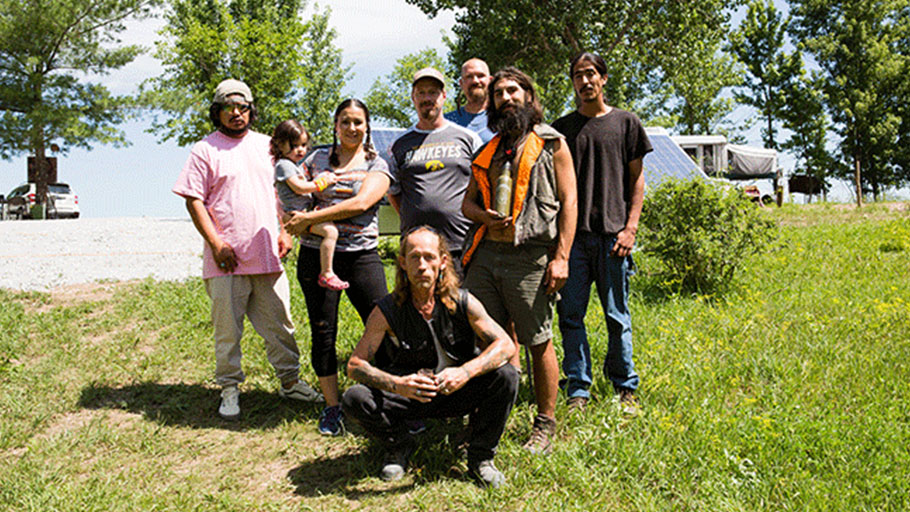
Lakasha, Nobiss and her daughter, Chris Truitt, Russell Binder, George Mccloskey, Brandon Saul, Terry Townsend. Nobiss says direct action can be one of the most powerful expressions of reparations. “It’s all about intention,” she says. “We saw reparations on the front lines at Standing Rock, when white people—who had come to realize how much violence and abuse people of color are facing—put their bodies in front of indigenous people to protect them.” — Photo by Jen Madigan
The event is far more instructive than key apology moments in the U.S. Neither Bill Clinton’s expression of regret in 1998 for slavery or the U.S. Congress’s official apology in 2008 for slavery and Jim Crow cut through the media haze in our country. Even more obscured was the 2009 apology to Native Americans enacted by Congress and President Obama, which was buried deeply and tragically within a defense appropriations bill. Few Americans are aware that any such official apologies were ever made.
Our nation desperately needs something akin to Australia’s National Sorry Day.
Even better, we can begin to envision the establishment of two such days of remembrance and apology—one in honor of Native Americans and another in honor of African Americans.
For such an accomplishment to come about, however, and for it to represent a real and abiding stride for justice and healing, we clearly need to find our way to the other side of a revolutionary cultural transformation. For those of us who are white and who grasp that almost everything that’s been taken can never be restored, this signals the gritty and painful internal work of grieving.
Nothing else, I believe, will equip us for the culture-shifting work that’s now needed in each and every one of our home communities. Nothing else will ready us to reach out to our brothers and sisters of color—to say sorry, person to person, in our own unique ways. Such simple, personal gestures may yet prove to be the most revolutionary actions of all.
Chris Moore-Backman is author of The Gandhian Iceberg: A Nonviolence Manifesto for the Age of the Great Turning and producer of Bringing Down the New Jim Crow, a radio documentary series. He offers heartfelt thanks to his daughter, Isa Anderson, for her vital contribution to this article.

